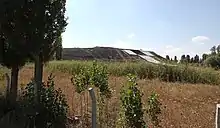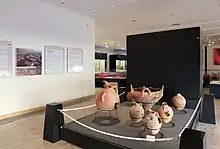Kaman-Kalehöyük
Kaman-Kalehöyük is a multi-period archaeological site in Kırşehir Province, Turkey, around 100 km south east of Ankara, 6 km east of the town center of Kaman.[1] It is a tell or mound site that was occupied during the Bronze Age, Iron Age and Ottoman periods. Excavations in the mound have been carried out since 1986 under the direction of Sachihiro Omura, on behalf of the Middle Eastern Culture Center in Japan and the Japanese Anatolian Archeology Institute.[2] The distance to Hattusa, the Hittite capital, is about 100 km.
 | |
 Shown within Turkey | |
| Location | Turkey |
|---|---|
| Region | Kırşehir Province |
| Coordinates | 39°21′46″N 33°47′12″E |
In 550 BC, Kırşehir and its region, along with the whole of Anatolia, came under Persian rule. Although no significant settlement remains and finds belonging to this period were found in Kırşehir, seals belonging to the Persian period were found in the Kaman Kale Höyük excavation. It is learned from the sources that there was a settlement named Zama here in ancient times. During the period of the Kingdom of Cappadocia, which was established in 333 BC, Kırşehir and its region were under intense pressure due to the lack of authority. In 18 AD, the Roman Emperor Tiberius officially annexed Cappadocia to Rome and made it a state. During the Roman period, the Kırşehir region spread rapidly in Christianity as well as paganism. In the Kaman region, there are remains of Byzantine buildings and the ruins of Ömerhacılı Castle. This indicates that there was a Byzantine settlement in the region.[3]
"Dark Age" period
According to the Japanese archaeologists,
- “In the levels belonging to the 2nd millennium B.C., a succession of cultural levels can be clearly seen, from the Assyrian Colony Period, Old Hittite Kingdom, and Hittite Empire Period.”[4]
Then, from the 12th century onward after the Hittite Empire collapsed, it is generally believed that a "Dark Age" had occurred in Anatolia, during which there were no significant cultural developments. So this period is believed to have lasted until the 8th century. But the excavations of Stratum IId at Kaman-Kalehöyük that belonged to the early part of this period (Early Iron Age) showed that life and cultural developments continued on this site.[5]
Stratification

The following is adapted from Omura 2011, pp. 1099–1100.[6]
I: Middle Ages (finds: hair brooches, 1 ceramic bowl, earrings and finger rings, stone lamp, coins, etc.)
- Ia Ottoman period
- Ib Byzantine period
II: Iron Age settlements finds: Fibulae and arrowheads, including some in Scythians style. Decorative plates made of animal bones, painted ceramics. In addition, Phrygian, Achaemenid and possibly one Elamite stamp seal were found.
- IIa1–2 Hellenistic period (Alexander the Great and later)
- IIa3–5 Late Iron Age (Lydian, Achaemenid)
- IIa6–IIc1 Middle Iron Age (Phrygian rule)
- IIc2–3 Middle Iron Age (Alişar IV)
- IId1–3 Early Iron Age (Dark Age )
III: Hittite period
- IIIa 15th ~ 12th century BC Hittite empire
- IIIb 17th ~ 15th century BC Old Hatti Empire
- IIIc 20th ~ 17th century BC Assyrian colonies
IV: Pre-Hittite period
- IVa Intermediate Period
- IVb Early Bronze Age
Metallurgy and glassware
In 2005, metallurgical analysis by Hideo Akanuma of iron fragments found at Kaman-Kalehöyük in 1994 and dating to c. 1800 BCE revealed that some of these fragments were composed of carbon steel; these currently form the world's earliest known evidence for steel manufacture.[7][8]
Also recently, some of the oldest glass in the world has been found at Kaman. This glass is estimated to be 3600-year-old [1600 BC].[9]
Kaman Kalehöyük Archaeological Museum

Kaman Kalehöyük Archaeological Museum, which was made as a grant by the Japanese Government within the framework of the "Cultural Heritage Preservation Project", covers a total area of 1,500 square meters, 830 square meters of which is open and 470 square meters of which is enclosed. It is located near the site.
In the museum, there are exhibition halls, a cine-vision corner, a library, a laboratory, cafe, warehouses and technical sections that allow examination, research, photography and restoration work.
The landscaping is arranged in the style of an excavated mound. Thus, the visitors were provided to see both the finds unearthed during the excavations and the excavation methods and works. Also, the largest botanical garden outside of Japan is built in a "Japanese garden" style.[10] The museum received the "Best green museum" award in 2011 and was nominated for the Museum of the Year in Europe in 2012.[11]
Buklukale
The site of Büklükale is located in Kırıkkale province, central Turkey near the town of Karakeçili (coordinates 39° 35’ 0” N by 33° 25’ 42” E). It is about 50km west of Kaman-Kalehöyük. The site is about 30 hectares in area. It was originally settled in the Middle Bronze Age through the Late Bronze Age before becoming part of the Hittite Empire. There was a walled Lower Town over-topped by a rocky outcrop at the riverside which contained significant building surrounded by a 7 meter high cyclopean wall. According to the excavators the upper city buildings were built around 1980 BC, destroyed around 1860 BC, then rebuilt to be destroyed again in 1680 BC.[12]
The location of Büklükale is significant because it is situated on the west bank at the narrowest point of Kızılırmak river that served as an important crossing-point through the ages. There is a Seljuk (13th century A.D.) bridge there, and the remains of a Roman bridge.
The Japanese archaeological team from the Japanese Institute of Anatolian Archaeology that excavated Kaman-Kalehöyük also conducted excavations here under the direction of K. Matsumura beginning in 2009.[13]
The site was settled since the Early Bronze Age period (the third millennium BC).[14]
A fragment of a Hittite cuneiform tablet was found here during excavations in 2010. This is the most westerly find of any cuneiform tablet in Turkey to date.[15]
References
- Steadman, Sharon R.; McMahon, Gregory (2011). The Oxford Handbook of Ancient Anatolia: (10,000 - 323 BCE). Oxford University Press. p. 1095. ISBN 978-0-19-537614-2. Retrieved 17 May 2015.
- "History of Conservation in Kaman-Kalehöyük, Turkey". American Society of Overseas Research (ASOR). Retrieved 2022-08-19.
- kirsehirkulturturizm. "History of Kaman" (in Turkish). Retrieved 2013-08-21.
- Kaman-Kalehöyük - Japanese Institute of Anatolian Archaeology
- Kaman-Kalehöyük - Japanese Institute of Anatolian Archaeology
- Sachihiro Omura: Kaman-Kalehöyük Excavations in Central Anatolia. In: Sharon Steadman (Hrsg.): Oxford Handbook of Ancient Anatolia, Oxford University Press, Oxford 2011, S. 1099–1110 (Based on German Wikipedia)
- Akanuma, H. (2005). "The significance of the composition of excavated iron fragments taken from Stratum III at the site of Kaman-Kalehöyük, Turkey" (PDF). Anatolian Archaeological Studies. Tokyo: Japanese Institute of Anatolian Archaeology. 14: 147–158.
- "Ironware piece unearthed from Turkey found to be oldest steel". The Hindu. Chennai, India. 2009-03-26. Archived from the original on 2009-03-29. Retrieved 2009-03-27.
- J. Henderson, S. Chenery, S. Omura, K. Matsumura and E. Faber (2018). Hittite and early iron age glass from Kaman-Kalehöyük and Büklükale, Turkey: evidence for local production and continuity? Journal of Anatolian Archaeology XX1, 1-15
- (Turkish) "Kırşehir Kaymakamlığı". 8 Aralık 2009 tarihinde kaynağından arşivlendi. Erişim tarihi: 8 Mayıs 2012.
- (Turkish) "Kaman Kalehöyük Müzesi". 3 Mayıs 2012 tarihinde kaynağından arşivlendi. Erişim tarihi: 8 Mayıs 2012
- Fairbairn, Andrew S., et al., "Ceremonial Plant Consumption at Middle Bronze Age Büklükale, Kırıkkale Province, Central Turkey", Vegetation History and Archaeobotany, vol. 28, no. 3, pp. 327–46, 2019
- Matsumura, Kimiyoshi (2020-12-01). "New Evidence on Central Anatolia during the Second Millennium BCE Excavations at Büklükale". Near Eastern Archaeology. University of Chicago Press. 83 (4): 234–247. doi:10.1086/708506. ISSN 1094-2076.
- Kimiyoshi MATSUMURA, Mark WEEDEN 2019, BÜKLÜKALE IN THE HITTITE PERIOD.
- Weeden M, "A Hittite Tablet from Büklükale", Anatolian Archaeol Stud 18, pp. 19–35, 2013
Literature
- Masao Mori, Sachhiro Omura: A Preliminary Report on the Excavations at Kaman-Kalehöyük in Turkey, in: P. Mikasa (Hrsg.): Essays on Ancient Anatolia and its surrounding Civilizations. Harrassowitz Verlag, Wiesbaden 1995.
- Masako Omura: Stamp Seals from Kaman-Kalehöyük dated from the 1st Millennium B.C., in: P. Mikasa (Hrsg.): Essays on Ancient Anatolia and its surrounding Civilizations. Harrassowitz Verlag, Wiesbaden 1995.
- Sachihiro Omura: Preliminary Report on the 22nd Excavation Season at Kaman-Kalehöyük in 2007. In: Anatolian Archaeological Studies 17, 2008, S. 1–43 PDF.
- Sachihiro Omura: Kaman-Kalehöyük Excavations in Central Anatolia. In: Sharon Steadman (Hrsg.): Oxford Handbook of Ancient Anatolia, Oxford University Press, Oxford 2011, S. 1099–1110.
External links
- Kaman-Kalehöyük at megalithic.co.uk
- Kaman Kalehöyük Archaeological Museum
- Kaman-Kalehöyük - Japanese Institute of Anatolian Archaeology